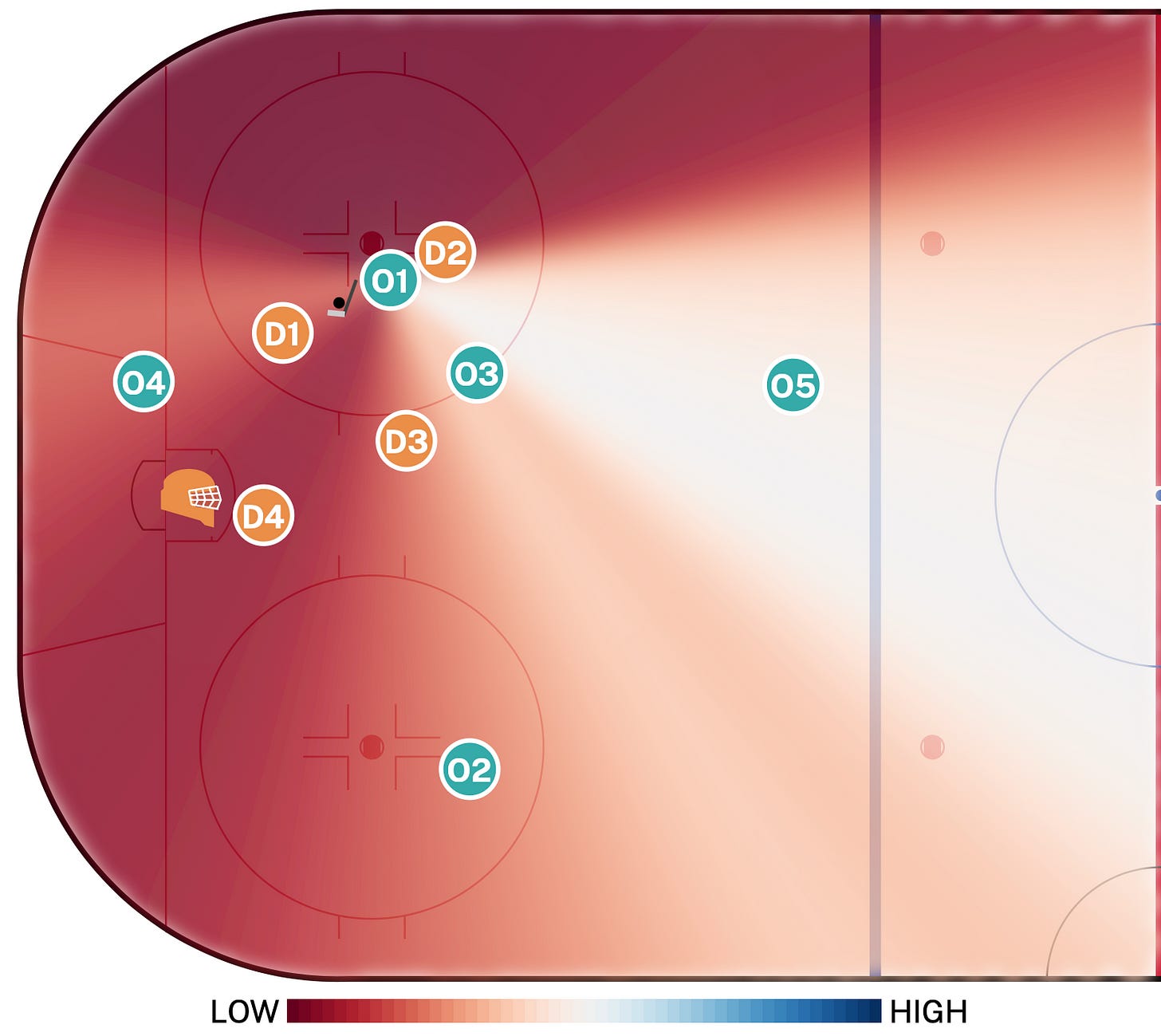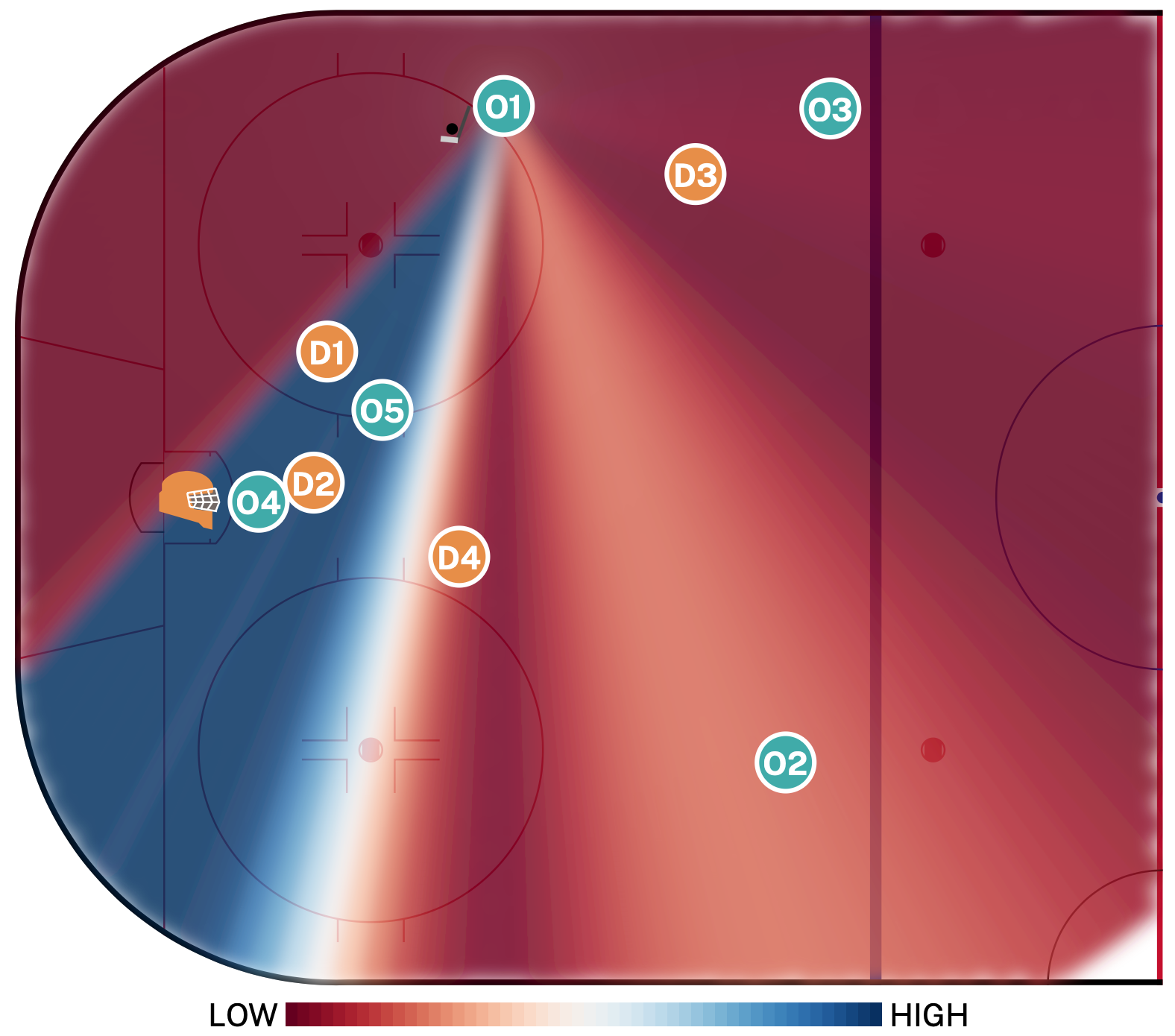April 29h, 2023: Analyzing the Gophers Power play from the 2022-23 season while breaking down their formation and success.
–> Follow @Dylanloucks4 on Twitter
Minneapolis, MINN – The Gophers scored 37 power-play goals this season on 138 attempts. I tracked all 138 attempts, here’s what I found on their team’s formation and where the puck was worked to before a shot. I also tracked the expected goals value on each shot and pass and assessed a value on the best pass available on each play.
The Data
Out of the 37 power-play goals the Gophers scored this season, 26 of them were scored in the home plate area. Think of the home plate area this way, draw a line from the tops of both circles then draw a line from each dot to the goalposts. The mental image should look like a home plate.
That means 70 percent of their power-play goals in the 2022-23 season were scored around the net or right in front. The Gophers scored six power-play goals on the road and 21 of them when they were the home team. They scored seven away from home ice but were the home team (four in Fargo and three in Tampa).
Here is a graphic of where the Gophers scored their power-play goals and who got them. The ones in Blue are home power-play goals and the ones in orange are away.

The Formation
Jackson LaCombe can be seen as the quarterback of the power play or as the graphic that I will show below, circle 05. Jimmy Snuggerud is circle 02 and plays most of the time to the right of the goalie on the face-off dot. As you can see above, pretty much every goal Snuggerud had was from that spot, mainly on one-timers.
Nelson played most of his power play minutes in front of the net or between the hash marks. In the formation the Gophers ran, Nelson would be referred to as the bumper. His positioning matters because he can do many things. He can screen the goalie or turn his body towards the puck to one-time a shot from the slot on net. He can also bump-pass pucks to almost everyone on the unit. Which is why it’s called the Bumper position.
Matthew Knies played a role on the 1-3-1 power play formation that is hard to defend. You saw a lot of Knies’ minutes parked right in front of the goaltender but Knies would also float below the goal line to catch passes from others and redirect passes to Nelson and Logan Cooley. Knies can be known as the net front guy on the power play.
Cooley played the right flank which makes sense considering he is a left shot. This allows Cooley to occasionally one-time shots but more importantly, set up plays. Plus it is always easier to cut to the slot from the right flank and rip a shot when you shoot left-handed.
Cooley, Nelson, Knies, Snuggerud, and LaCombe mainly made up the top unit for Minnesota.
How’d It Work?
Now, I want to take to you a specific power-play goal. Most of the power-play goals the Gophers scored this year were a result of Minnesota attacking the front of the net or attacking the box.
The Gophers opened the 2022-23 season with a power-play goal against Lindenwood on October 1st. The goal came from Nelson on a nice pass from Knies.
Let’s break it down.
You will see it in the goal about to be shown but Knies can also power cut to the front of the net for a shot which we saw the big six-foot-three power forward do a lot. Knies worked best there because of his size and IQ but also his shot has to be respected and as you can see in the graphic above, every goal he scored was scored right on top of the goalie.
In the clip below, Cooley and Knies actually switched spots after Cooley passed it to Knies. This slight change caused a Lindenwood defender to leave his position in the box penalty kill they were running. This slight change left Nelson open for a shot but only if Knies could put it right on Nelson’s blade.

Side note: everyone check out An Nguyen on Twitter. She has a ton of very fascinating work that I love to look at. Plus her models are great!
As you can see from the graphic Knies’ best pass that results in a high danger chance would be to Nelson who is circle 03 on the photo. The best probability of the pass being received would be to LaCombe (05) or Cooley (04).
The position Knies put himself in shows medium danger or slight danger which is shown in white coloring. The actual goal itself is a result of the Gophers attacking the box that the opposing team sets up in front.
Taking into account the pass, the shot, and the switch up between Cooley and Knies, the expected goals value on this play was .488 which is a medium danger chance according to my model.
Click here for a video of the goal.
I want to give you another example of a power play goal by the Gophers scored against Canisius in the NCAA Regional Semifinals to make it 5-2 Gophers in the third period.

The goal by Brody Lamb was the result of using a Canisius defender as a screen and firing a shot from the face-off dot. Another example of attacking the box.
If you look at the photo above, Lamb’s best successful pass option would be to pass it across to the far boards for Ryan Johnson or dish it back behind him for Brock Faber.
Canisius is did a good job of boxing the two Gophers out in the slot and forcing a perimeter shot.
But Lamb doesn’t fall into the trap and PK of Caniuis but rather attacks the box by driving the play toward the net.

As you can see from the photo above, Lamb’s best high-danger chance would be to get the puck in front of the net to either Rhett Pitlick (05), Connor Kurth (04) or take it himself.
Brody Lamb gives @GopherHockey a 5-2 lead! @MN_NCAA pic.twitter.com/4h8tnesEnC
— Alex Micheletti (@AlexMicheletti) March 24, 2023
This isn’t to say that perimeter shots aren’t dangerous because they can be if you have enough traffic in front or have guys like Snuggerud, Mike Koster, and LaCombe blasting shots from the point.
Which we saw a lot of.
Final Thoughts
The Gophers had a lot of success in the 2022-23 season on the power play. Many teams didn’t even want to give the Gophers power plays based on Minnesota’s success.
Minnesota ranked fourth in the NCAA in power play percentage, converting at 26.8 percent. They scored 37 power-play goals but did it on 20 fewer opportunities than the three teams in front of them.
Denver had 182 chances, North Dakota had 164 chances, Minnesota State had 156 chances, and the Gophers had 138 chances.
Look for the Gophers to keep the same formation next season to capitalize on every power play chance they get.